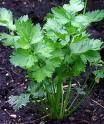Celery
Apium graveo/ens Umbelliferae/Apiaceae Also called Smallage, Wild celery, Chinese celery. A biennial plant with a ridged, shiny stem, celery can grow to a height if 45cm. The stalks if the wild plant have an unpleasant taste and should not be confused with those if the cultivated variety. The plant has indented, aromatic leaves and small, white flowers. The small, brown seeds have a characteristic celery odour and taste. Parts usedSeeds The seeds are collected during summer and autumn. ConstituentsThe seeds contain 1.5 to 3 per cent essential oil. mainly limonene. Phthalides present in the oil impart celery's characteristic odour. The seeds also contain coumarins, flavonoids and furanocoumarins. Medicinal usesCelery seeds have traditionally been used to treat rheumatism and tests performed in 1998 confirmed celery's anti-inflammatory and pain-killing qualities. Celery is also useful in treating arthritis and gout, perhaps as a result of its diuretic action, which may help to remove the toxins associated with these conditions. CAUTIONS
PREPARATION AND DOSAGEFor internal use TO TREAT rheumatism, arthritis and digestive problems INFUSION Put 1 teaspoon of seeds into a cup of boiling water. Infuse for 5-10 minutes, strain and drink 1 cup a day. TINCTURE Take 30 drops in water three times a day. LIQUID EXTRACT (diluted 1:1 in 90% alcohol) Take 0.5-2ml three times a day. IF SYMPTOMS PERSIS CONSULT A DOCTOR CultivationGrow from seed sown in spring, in damp, nutrient-rich soil in a sheltered location. |
Ayurveda Book
This book on Ayurveda is meant for people interested to know about basics concepts of Ayurvedic healing and learn ayurveda concepts. Though there are many books Read More My SitesReal Testimonials
Connect with us |







